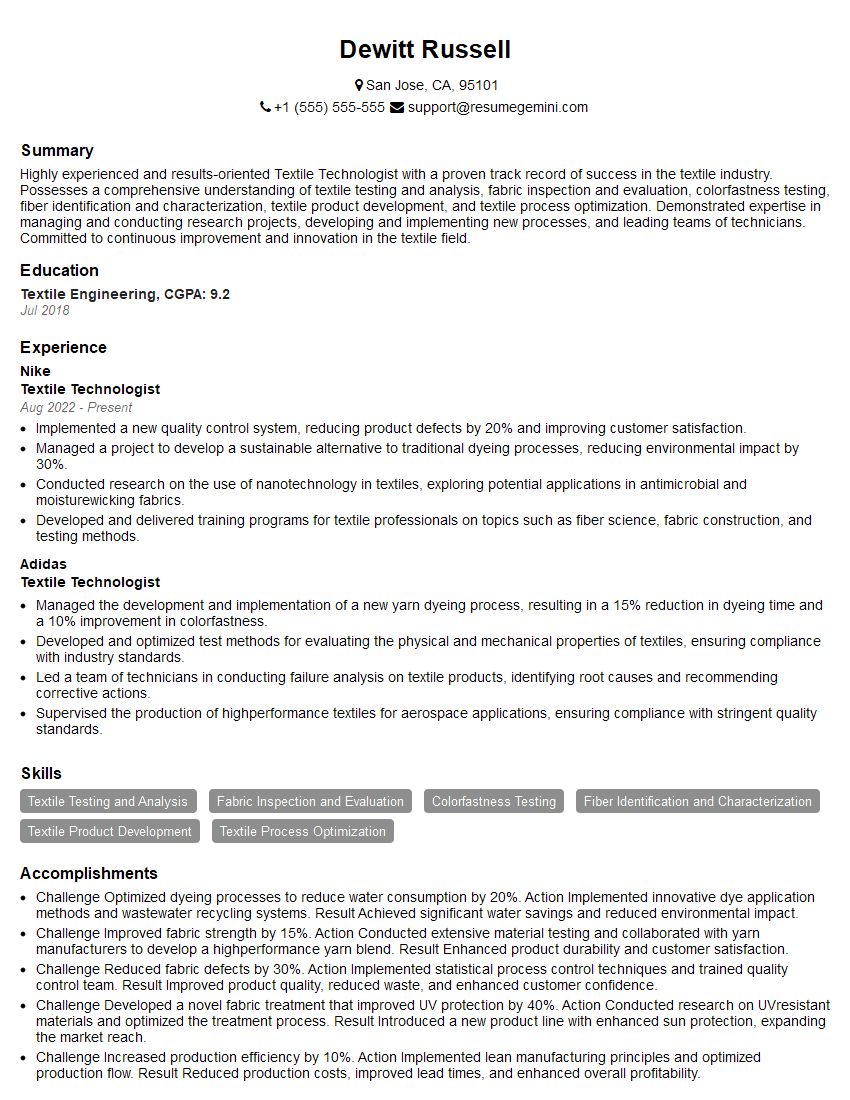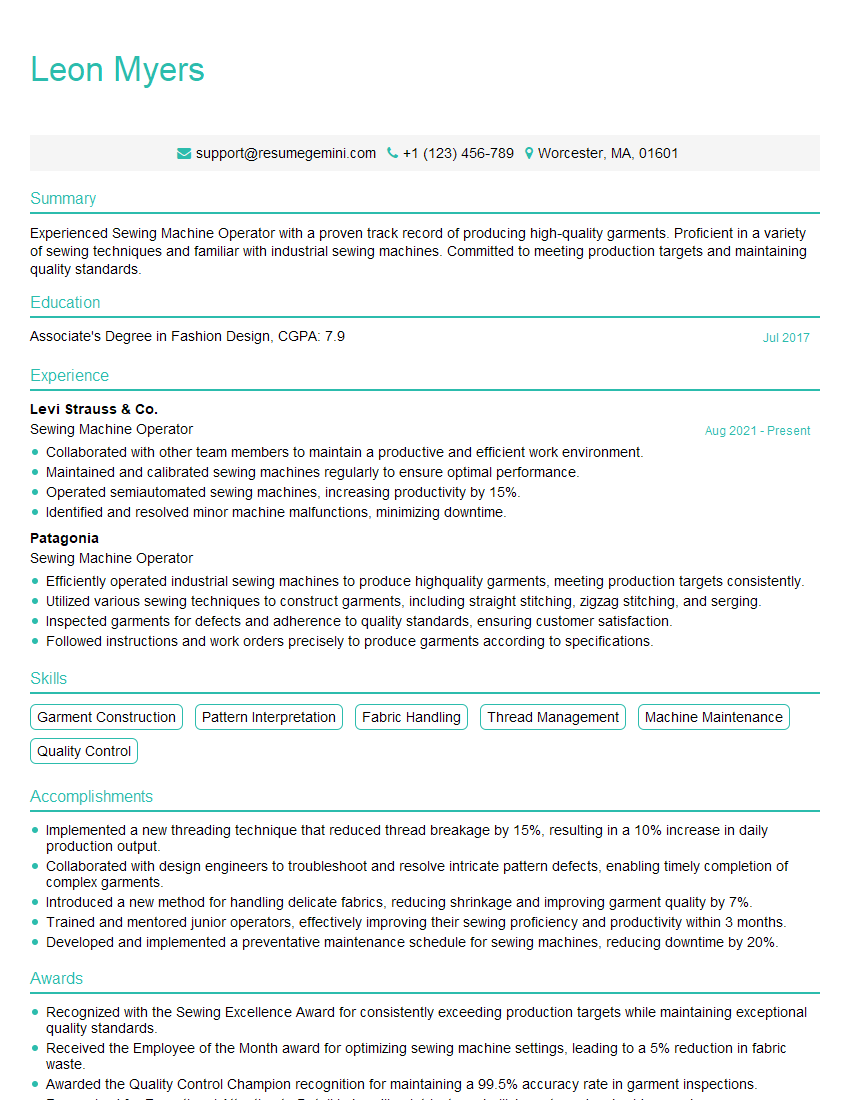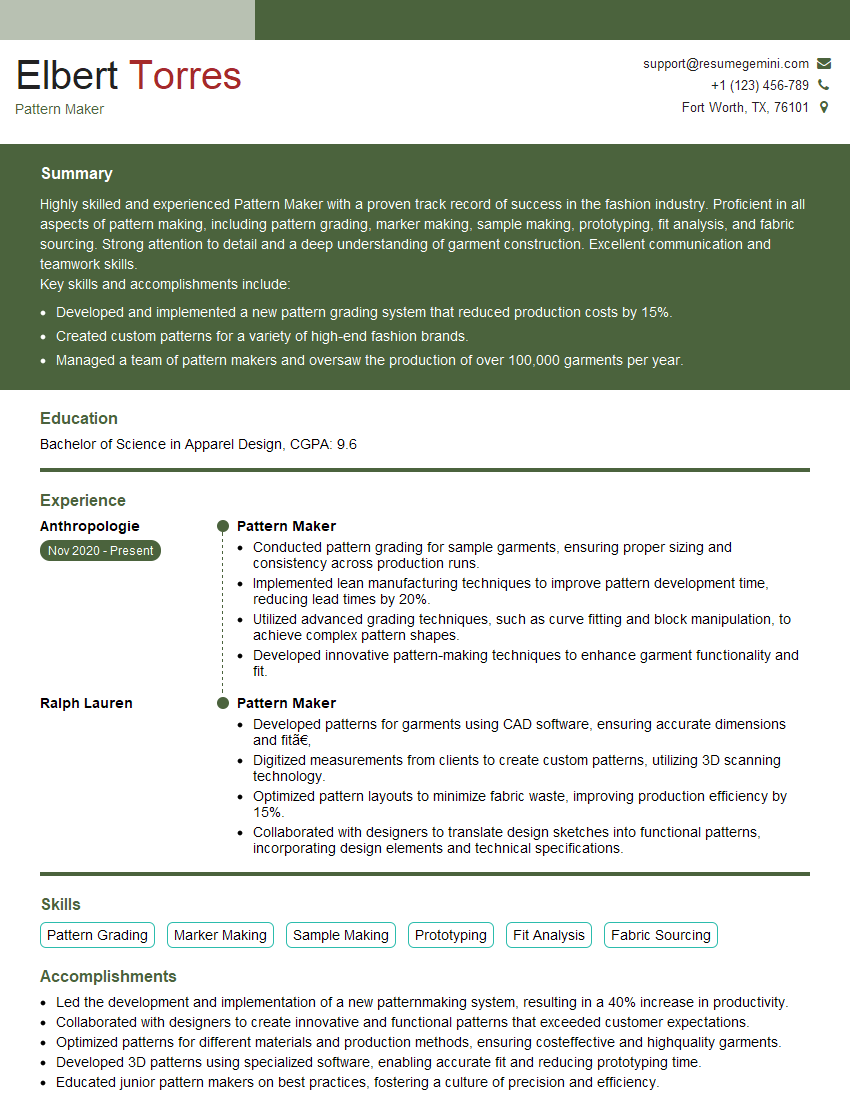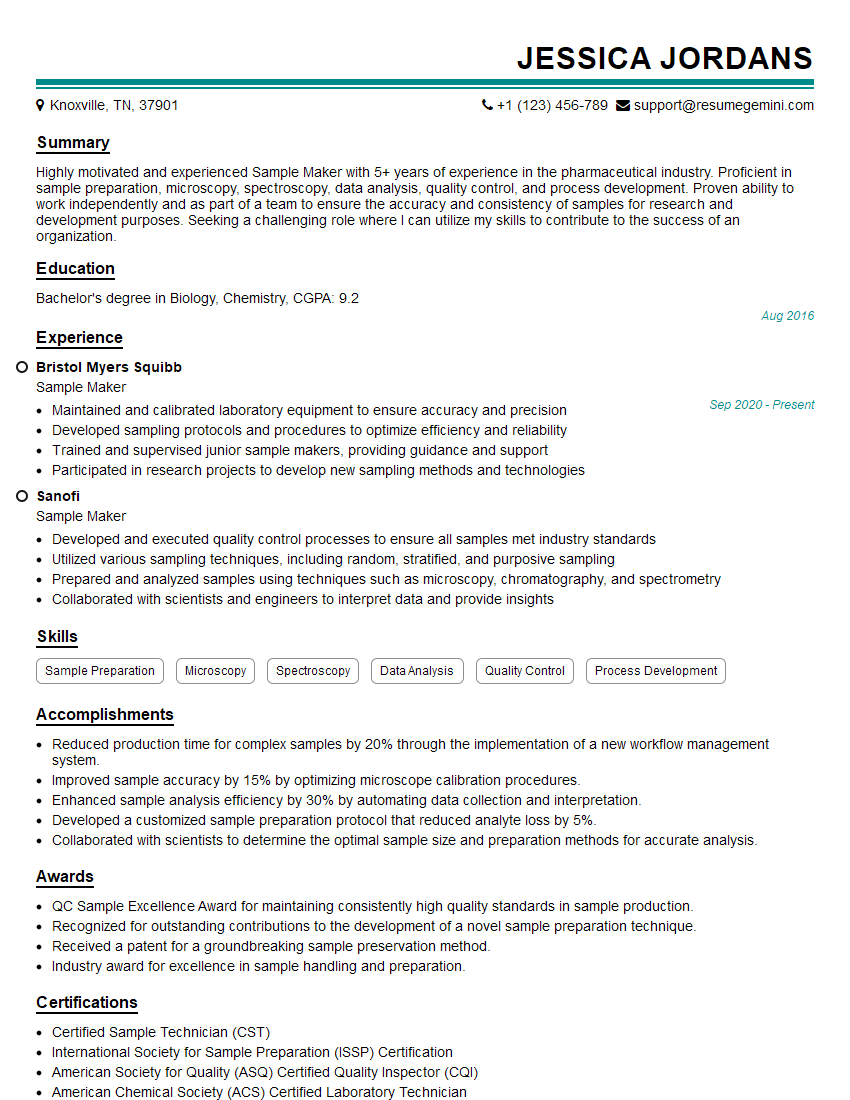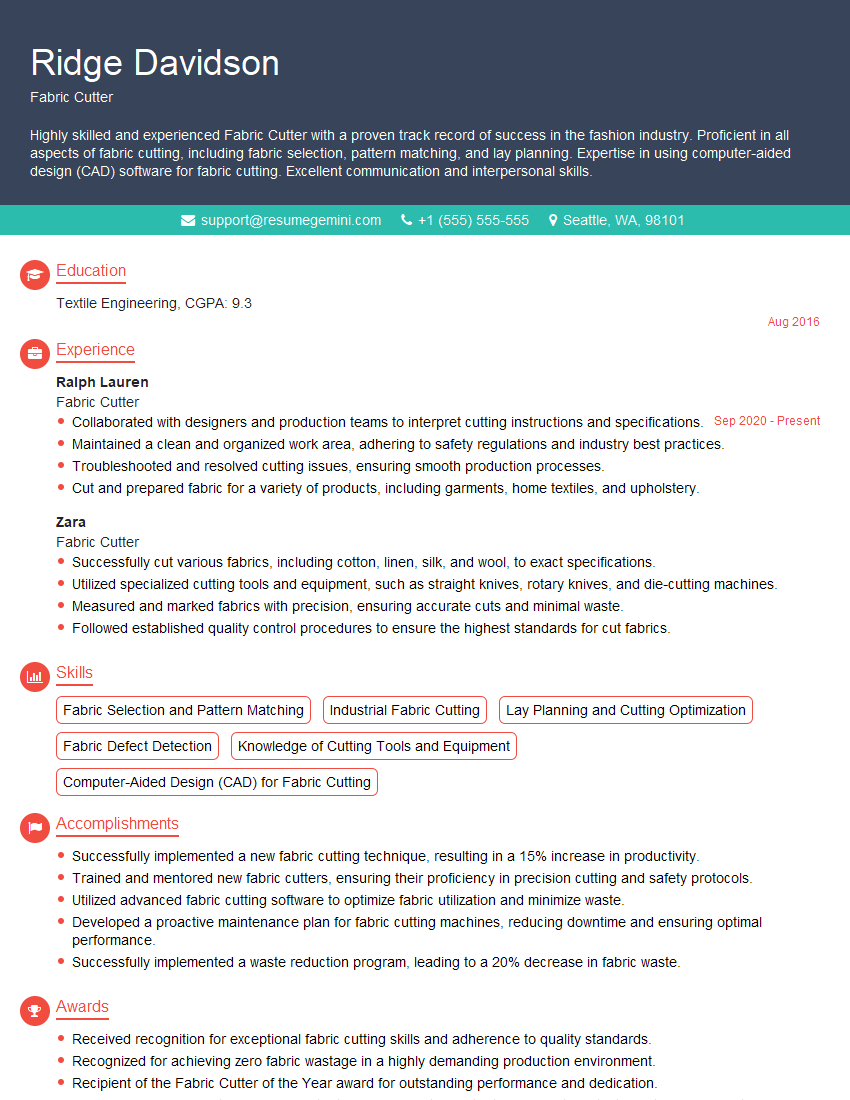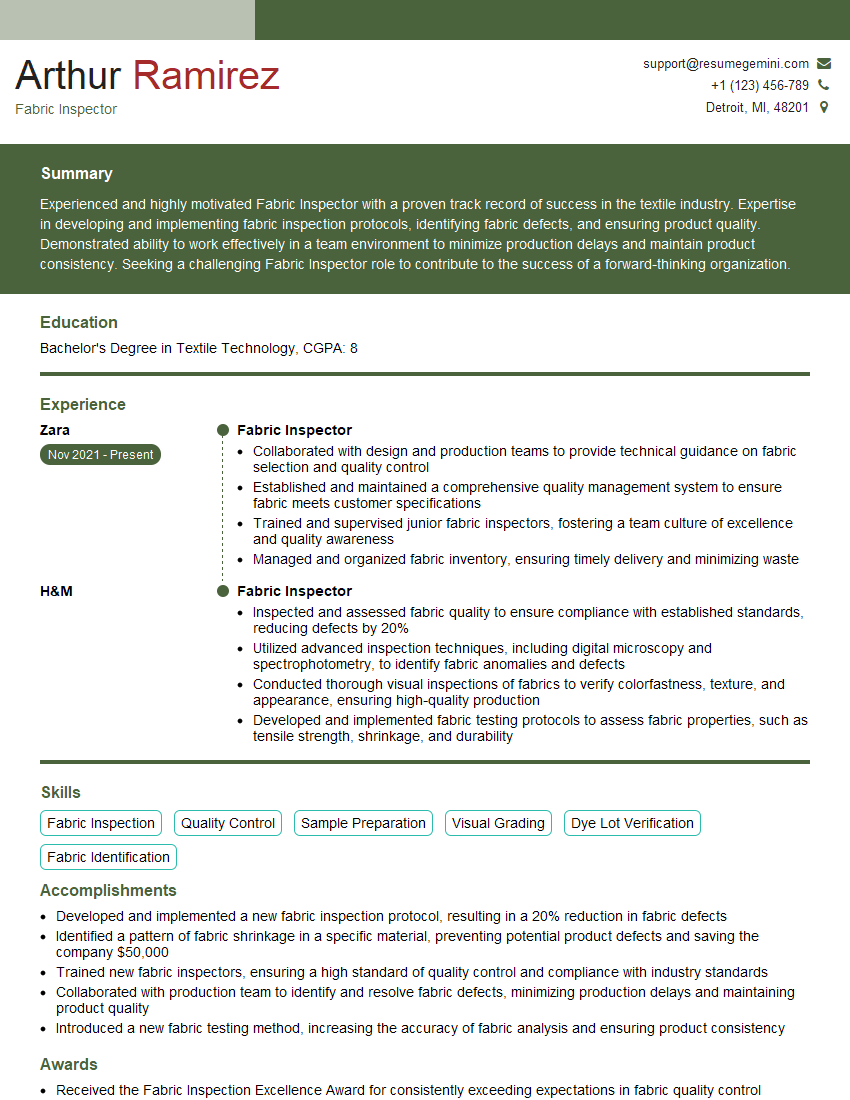Cracking a skill-specific interview, like one for Proficiency in Fabric Handling and Preparation, requires understanding the nuances of the role. In this blog, we present the questions you’re most likely to encounter, along with insights into how to answer them effectively. Let’s ensure you’re ready to make a strong impression.
Questions Asked in Proficiency in Fabric Handling and Preparation Interview
Q 1. Explain the different types of fabric finishes and their impact on handling.
Fabric finishes significantly impact how a fabric handles during the manufacturing process. They alter properties like drape, texture, and durability. Different finishes cater to specific needs and aesthetic goals.
- Mercerization: A treatment for cotton that improves its luster, strength, and dye affinity. Mercerized cotton is smoother and easier to sew than untreated cotton, but requires careful handling to prevent snags.
- Calendering: A mechanical process that presses fabric to create a smooth, glossy, or embossed surface. Calendered fabrics can be easier to cut cleanly but are more susceptible to creasing.
- Sanforizing: A process that pre-shrinks fabric to minimize shrinkage after washing. This is crucial for handling, as unsanforized fabrics can distort during later stages of production.
- Water Repellent Finishes: These finishes increase water resistance. The resulting fabric requires careful handling during cutting, as the treated surface may be more resistant to shearing.
- Flame Retardant Finishes: These enhance fire safety. These fabrics often have a slightly different feel and might require specific cutting and sewing techniques due to their modified composition.
Understanding these finishes is key to selecting appropriate handling methods, preventing damage, and ensuring a high-quality end product. For instance, a delicate, mercerized cotton requires gentler handling than a durable, flame-retardant canvas.
Q 2. Describe your experience with various fabric types (e.g., cotton, silk, synthetics).
My experience spans a wide range of fabrics, each with unique handling characteristics:
- Cotton: I’m highly proficient in handling various cotton types, from fine Egyptian cotton (requiring delicate care) to heavy-duty denim (needing robust handling). I understand how pre-washing affects shrinkage and how different weaves (e.g., twill, poplin) influence cutting techniques.
- Silk: Silk’s delicate nature demands careful handling. I’m adept at recognizing its potential for snagging and shearing, using appropriate tools and techniques to minimize damage. The process of pattern matching on silk is crucial, and my experience allows me to do this efficiently and effectively.
- Synthetics (Polyester, Nylon, etc.): Synthetics can be slippery and prone to static cling. I’m experienced in managing these challenges, employing appropriate pressing and handling techniques to avoid issues like stretching or puckering during the cutting process. Knowledge of fabric blends and their behavior is also critical.
- Linen: Linen’s tendency to wrinkle and fray requires specific handling techniques. I know how to properly press and cut linen to prevent damage during the cutting process.
- Wool: Depending on the type of wool and the finish, handling techniques will vary. I’m experienced in working with different types of wool and using specialized cutting tools and techniques to avoid damaging the fabric.
This broad experience allows me to adapt my approach to each fabric, preventing damage and maximizing efficiency.
Q 3. How do you identify fabric defects during inspection?
Identifying fabric defects is a crucial aspect of my role. My inspection process involves a systematic approach, combining visual examination with tactile assessment.
- Visual Inspection: I meticulously examine the fabric for irregularities such as holes, stains, discoloration, weaving inconsistencies (e.g., slubs, broken ends), and print defects.
- Tactile Inspection: I run my hands over the fabric to detect texture variations, stiffness inconsistencies, and potential weaknesses that might not be visually apparent. This is especially crucial for fabrics with complex weaves or finishes.
- Measurement & Alignment: I verify the fabric’s dimensions and check for proper alignment of patterns or designs. This is especially critical for intricate patterns and requires a keen eye for detail.
I use standardized grading systems to document the severity of defects, ensuring consistent evaluation. For example, I would document a small, barely noticeable imperfection differently than a significant hole or large area of discoloration.
Q 4. What methods do you use to prevent fabric damage during handling?
Preventing fabric damage during handling is paramount. My strategies include:
- Proper Storage: Fabrics are stored in clean, dry environments, away from direct sunlight and heat, minimizing damage from moisture or extreme temperatures. They are folded or rolled carefully to prevent creases and wrinkles.
- Careful Handling: I use appropriate lifting and moving techniques, avoiding sharp pulling or tugging which could damage the fibers. This is especially important with delicate fabrics like silk or lace.
- Clean Workspace: Maintaining a clean and clutter-free workspace eliminates the risk of contamination and accidental damage from debris or sharp objects. This is also especially important for fabrics that show any potential discoloration easily.
- Appropriate Tools: I use sharp, well-maintained cutting tools and always use rotary cutters with self-healing cutting mats to prevent damage to the fabric. When necessary, I use specialized tools for delicate fabrics to avoid snagging or tearing.
- Protective Measures: Using protective materials like pattern weights, tissue paper, or cutting mats helps minimize damage from pins, needles, or the cutting process itself. For particularly delicate fabrics, layers of protective paper can be used during cutting.
By consistently following these measures, I ensure that fabrics are handled with the utmost care, minimizing loss and maintaining the integrity of the material.
Q 5. Explain the importance of pre-washing fabrics before cutting and sewing.
Pre-washing fabrics is a crucial step before cutting and sewing, primarily to address shrinkage and colorfastness.
- Shrinkage Control: Pre-washing removes any potential for significant shrinkage after the garment is completed, ensuring accurate pattern cutting and consistent sizing throughout the production process. This saves time and reduces waste by avoiding alterations needed after garments are sewn.
- Colorfastness: Pre-washing helps determine the colorfastness of the fabric, preventing dye bleeding or running during the sewing and washing processes of the final garment. This prevents a variety of problems such as discoloration and color transfer.
- Removing Sizing: Many fabrics are treated with sizing agents that can interfere with sewing and affect the drape of the finished garment. Pre-washing removes sizing and ensures the fabric performs as expected.
- Fabric Relaxation: Pre-washing can help relax the fabric fibers, making it easier to work with and resulting in a more professional final garment.
Ignoring this step can result in significant issues, like misshapen garments and color transfer problems. Pre-washing ensures consistency and quality, enhancing the professional finish of the final product.
Q 6. How do you determine the appropriate cutting techniques for different fabrics?
Selecting appropriate cutting techniques hinges on understanding the fabric’s properties. Different fabrics require different approaches to minimize damage and achieve clean cuts.
- Lightweight Fabrics (Silk, chiffon): These delicate fabrics require sharp shears, careful handling, and potentially the use of tissue paper under the fabric to prevent slipping or stretching.
- Medium-Weight Fabrics (Cotton, linen): These are generally easier to cut, but proper alignment is important, and rotary cutters or sharp shears are recommended.
- Heavyweight Fabrics (Denim, canvas): These fabrics benefit from sharp blades and possibly a cutting mat to prevent dulling the blades and to help with precise cutting.
- Stretchy Fabrics (Knit fabrics): These fabrics often require specialized cutting tools, like electric shears or special rotary cutters, and necessitate careful handling to prevent stretching or distortion during the cutting process. Careful consideration of grainlines is especially critical.
- Pile Fabrics (Velvet, corduroy): These materials should be cut with the pile running in a consistent direction, and sharp blades help minimize damage to the pile, often requiring specialized tools for cutting.
My experience allows me to quickly assess the fabric and select the most appropriate tools and techniques, ensuring efficient and damage-free cutting.
Q 7. Describe your experience with using different cutting tools and equipment.
I’m proficient in using a variety of cutting tools and equipment:
- Shears: I have extensive experience with various types of shears, from small, detail shears for intricate work to large, heavy-duty shears for cutting multiple layers of fabric. Proper maintenance and sharpening are crucial to ensure clean cuts and prevent fabric damage.
- Rotary Cutters: I’m skilled in using rotary cutters for efficient cutting of large quantities of fabric, especially with layered cuts. Safety and precision are always prioritized, along with the use of appropriate self-healing cutting mats.
- Electric Shears: I use electric shears for cutting heavy fabrics and intricate designs. Their power and precision are particularly helpful for challenging materials.
- Pattern-Making Equipment: I’m familiar with pattern-making tools like rulers, French curves, and other precision instruments that aid in creating and manipulating patterns for optimal fabric utilization. This ensures that the patterns are efficiently placed onto the fabric and are perfectly cut.
- Pressing Equipment: Pressing is a crucial complement to cutting. I’m proficient in using industrial-grade irons and pressing equipment to ensure the fabric is optimally prepared for accurate pattern placement and cutting.
My ability to adapt my tool selection to the fabric type and project requirements is a significant asset.
Q 8. How do you manage fabric shrinkage during the production process?
Managing fabric shrinkage is crucial for consistent garment sizing and minimizing waste. It involves understanding the fabric’s inherent properties and applying appropriate pre-treatment methods. Different fabrics shrink differently; natural fibers like cotton and wool are more prone to shrinkage than synthetics like polyester.
My approach begins with identifying the fabric type and consulting its shrinkage specifications from the supplier. This information usually indicates the expected shrinkage percentage after washing. We then use pre-shrinking techniques, such as a controlled washing and drying process, before cutting and sewing. This process mimics the conditions the garment will experience later, minimizing shrinkage after the final product is made.
For instance, with a cotton fabric expected to shrink 5%, we would wash and dry the fabric in a controlled environment to achieve that shrinkage before pattern cutting. This ensures the final garment closely matches the intended size. For highly delicate fabrics, a gentler pre-shrinking process using steam is employed.
Q 9. Explain your experience with fabric spreading and layering techniques.
Fabric spreading and layering are fundamental to efficient and accurate cutting. Proper spreading ensures uniform fabric tension, preventing distortion and improving cutting accuracy. Layering multiple fabric plies optimizes cutting time and material utilization.
My experience includes using both manual and automated spreading machines. Manual spreading requires meticulous attention to detail – ensuring the fabric is smoothly and evenly spread, free from wrinkles or creases. This often involves using a spreading board and carefully guiding the fabric to maintain consistent tension. Automated spreaders offer greater speed and precision but still require skilled operators for monitoring the process and handling potential fabric irregularities.
Layering techniques depend on the fabric type and cut requirements. For example, lighter fabrics can be layered more deeply than heavier ones to avoid slippage or difficulty cutting. Marking systems, such as chalk or laser cutting guides, are crucial for maintaining precise alignment across layers. I’ve successfully implemented different layering strategies based on the fabric and design, leading to better yield and reduced waste.
Q 10. How do you ensure accurate fabric measurement and cutting?
Accurate fabric measurement and cutting are paramount to producing high-quality garments. Inaccuracy leads to inconsistencies in sizing, waste, and potential production delays.
We utilize calibrated measuring tools, like rulers and tape measures, to ensure precision. Pattern pieces are carefully laid out on the fabric, ensuring correct alignment and spacing. Modern cutting technologies, such as automated cutting systems and electronic markers, enhance precision and speed. However, even with advanced technology, a skilled operator is needed to check for accurate placement and address any irregularities.
A crucial aspect is double-checking measurements throughout the cutting process, both before and after. Regular calibration of equipment and stringent adherence to standardized procedures are key in preventing errors. For example, we always cross-check measurements taken manually using two separate methods, and our cutting machines undergo routine maintenance checks to maintain accuracy.
Q 11. Describe your experience with different fabric storage and handling methods.
Fabric storage and handling are crucial for preserving fabric quality and preventing damage. Improper storage can lead to fabric discoloration, deterioration, and even pest infestation.
My experience encompasses various methods, from utilizing roll-based storage systems for large quantities of fabric to flat storage for smaller quantities or delicate fabrics. Roll-based systems often involve specialized racking to ensure even weight distribution and prevent damage. Flat storage typically uses shelves and protective covers to shield fabrics from light and dust. Proper labeling and inventory management are crucial to efficient retrieval and tracking.
For different fabric types, I have implemented specific storage practices: Delicate fabrics are stored carefully to prevent creasing, while heavy fabrics require sturdier shelving. Maintaining consistent temperature and humidity levels in the storage area is critical for preventing damage, especially to natural fibers. We strictly prohibit direct sunlight or high-moisture environments.
Q 12. How do you maintain the cleanliness and organization of the fabric cutting area?
Maintaining a clean and organized cutting area is critical for safety, efficiency, and product quality. A cluttered area increases the risk of accidents, delays production, and can even contaminate fabrics.
We implement a 5S methodology (Sort, Set in Order, Shine, Standardize, Sustain) for workplace organization. This includes regular cleaning and removal of debris, organizing tools and equipment, and establishing clear pathways. We use designated containers for scraps and waste, ensuring quick and easy disposal. Regular sweeping, vacuuming, and occasional deep cleaning are standard practice.
Clear signage and color-coded systems are used to identify different fabric types and designated workspaces. This system aids quick identification and improves workflow. We conduct daily cleaning routines at the end of each shift, and weekly deep cleaning sessions further ensure a safe and efficient workspace. This diligent approach not only enhances efficiency but also minimizes the risk of contamination and damage.
Q 13. How do you handle fabric that is damaged or defective?
Handling damaged or defective fabric requires careful assessment and appropriate action. This is crucial for minimizing waste and ensuring product quality. The approach depends on the nature and extent of the damage.
Minor defects might be salvaged by careful trimming or using the undamaged portions. Significant damage usually requires discarding the fabric. A thorough inspection is conducted to identify the extent of the damage. We meticulously document all defects and their locations. This information is useful in identifying potential issues with the fabric supply chain. For major defects, a thorough investigation is implemented to prevent similar issues in future batches.
Segregating damaged fabric is vital to avoid accidental use. We use clearly marked containers to distinguish damaged fabric from usable fabric. The disposal method depends on local regulations and environmental considerations. Recycling options are always explored when feasible. Detailed records of defective fabrics, including causes and quantities, help in identifying sources of defects and implementing preventative measures.
Q 14. Explain your understanding of fabric quality control procedures.
Fabric quality control is a multi-stage process that ensures consistent quality throughout the production cycle. It involves inspecting fabrics at various stages, from incoming inspection to finished goods.
Incoming inspection involves verifying the fabric against the specifications provided by the supplier, checking for defects like discoloration, inconsistencies in weight, or weaving flaws. This often involves visual inspection and sometimes laboratory testing, depending on the fabric’s complexity. During the production process, regular checks are made to ensure the fabric remains free from damage or contamination.
Final quality checks are conducted on completed garments to ensure they meet the required standards. This might involve examining seams, hems, and other details for defects. Statistical process control (SPC) charts are sometimes used to monitor quality metrics throughout the process. Quality control procedures are crucial for maintaining customer satisfaction and building brand reputation. Proper documentation at each stage is maintained for tracking and continuous improvement.
Q 15. How do you use color matching techniques to ensure consistency?
Color matching is critical for maintaining consistency in fabric production. We use a multi-pronged approach, combining visual assessment with instrumental color measurement to minimize discrepancies.
Firstly, we use standardized color charts, like Pantone, to define target colors. These charts provide a universal language for color communication, preventing misunderstandings between designers, manufacturers, and quality control personnel. For example, specifying a Pantone 19-1664 TPX ensures everyone understands the exact shade of ‘Rose Quartz’.
Secondly, we employ spectrophotometers, which measure the precise color values of fabric samples. These readings are compared to the target values. Any deviation beyond a predetermined tolerance (typically expressed as a Delta E value) flags the need for adjustments in dyeing or sourcing. A low Delta E value, ideally below 2, indicates excellent color matching.
Finally, we maintain detailed records of each batch’s color measurements and related production data. This historical data helps us identify potential sources of variation and improve our color matching processes over time. It’s like keeping a recipe book – if a batch doesn’t turn out right, we can review our notes and refine the process for future consistency.
Career Expert Tips:
- Ace those interviews! Prepare effectively by reviewing the Top 50 Most Common Interview Questions on ResumeGemini.
- Navigate your job search with confidence! Explore a wide range of Career Tips on ResumeGemini. Learn about common challenges and recommendations to overcome them.
- Craft the perfect resume! Master the Art of Resume Writing with ResumeGemini’s guide. Showcase your unique qualifications and achievements effectively.
- Don’t miss out on holiday savings! Build your dream resume with ResumeGemini’s ATS optimized templates.
Q 16. Describe your experience with fabric testing and quality assurance methods.
My experience encompasses a broad range of fabric testing and quality assurance methods. This includes assessing fabric strength (tensile strength, tear strength), evaluating its durability (abrasion resistance, pilling), checking colorfastness (to washing, light, and rubbing), and examining its dimensional stability (shrinkage, stretching).
I’m proficient in using various testing instruments, from simple tensile testers to sophisticated spectrophotometers and microscopes. I also have experience with standard testing methods outlined by organizations like AATCC (American Association of Textile Chemists and Colorists) and ISO (International Organization for Standardization). For instance, the AATCC Test Method 16 is frequently used to evaluate colorfastness to washing.
A crucial aspect of my work involves documenting and analyzing test results to ensure they meet pre-defined quality standards. This often includes creating comprehensive quality control reports, identifying potential issues, and recommending corrective actions. A practical example was when we discovered a batch of fabric had lower tear strength than the specification. Through meticulous investigation using microscopy, we pinpointed a problem in the weaving process, allowing for immediate corrective action and prevention of further defects.
Q 17. What are your strategies for managing fabric inventory?
Effective fabric inventory management is crucial for efficient production and cost control. My strategy combines meticulous record-keeping with strategic forecasting and space optimization techniques.
We use a computerized inventory management system (IMS) to track each fabric’s type, quantity, color, and supplier information. This allows for real-time visibility into stock levels, helping us avoid shortages and overstocking. We regularly audit our physical inventory against the IMS data to maintain accuracy.
For forecasting, we analyze historical sales data and upcoming production schedules to predict future fabric needs. This helps us determine optimal order quantities and minimize storage costs. We also prioritize the organization of our warehouse to ensure easy accessibility to frequently used fabrics, improving efficiency and workflow.
Furthermore, we establish clear quality control protocols during incoming inspections to verify fabric meets specifications before it is added to our inventory. This ensures that only top-quality materials are used in production.
Q 18. How do you prioritize tasks to meet production deadlines?
Prioritizing tasks to meet production deadlines requires a structured approach. I typically utilize a combination of methods, including Kanban boards, Gantt charts, and prioritization matrices.
Firstly, I assess the urgency and importance of each task, often using a matrix that categorizes tasks as urgent/important, important/not urgent, etc. This allows me to focus on the most critical tasks first.
Secondly, I break down complex tasks into smaller, more manageable sub-tasks, assigning deadlines to each one. This improves tracking and provides a clearer path towards completion. Visual tools like Kanban boards help visualize workflow and track progress, facilitating seamless collaboration within the team.
Finally, I actively monitor progress, regularly adjusting priorities as needed based on unforeseen challenges or changing circumstances. This flexible, adaptive approach is essential for navigating the dynamic nature of production environments. For example, if a critical fabric delivery is delayed, I might need to re-prioritize tasks to mitigate its impact.
Q 19. Explain your problem-solving approach when facing fabric-related challenges.
My problem-solving approach to fabric-related challenges is systematic and data-driven. I follow a structured process that involves:
- Identify the problem: Clearly define the nature of the issue. Is it a quality defect, a production bottleneck, or a supply chain disruption?
- Gather data: Collect relevant information, such as test results, production records, and supplier feedback. This is like being a detective – you need evidence to solve the case.
- Analyze the data: Identify patterns, root causes, and potential contributing factors. Tools such as statistical process control (SPC) charts can be helpful here.
- Develop solutions: Brainstorm potential solutions and evaluate their feasibility and impact.
- Implement the solution: Choose the most effective solution and implement it, closely monitoring its effectiveness.
- Document and review: Document the problem, the solution, and the outcome for future reference. This helps prevent similar issues from recurring.
For instance, if we experienced inconsistencies in fabric dyeing, I would meticulously analyze the dyeing process parameters, investigate the dye lot, and examine the water quality. This systematic approach helped me pinpoint the source of the problem and implement a solution to improve consistency.
Q 20. Describe your experience with working with different fabric patterns and designs.
I possess extensive experience working with a diverse range of fabric patterns and designs. This includes everything from simple solids and stripes to complex jacquards, intricate embroideries, and digitally printed textiles.
My expertise extends beyond merely handling these fabrics; I understand how different patterns and designs influence fabric behavior during processing. For example, I understand that intricate designs can affect the fabric’s drapability, the potential for snagging or tearing, and its suitability for different finishing processes.
I have experience in working with various types of fabric patterns, including woven and knitted fabrics with different weave structures, prints, and embroideries. I also take into account the different materials used in the pattern, such as yarns or threads, and how they affect the overall durability and quality of the fabric. This nuanced understanding is crucial for ensuring the finished product meets the design specifications and maintains its integrity throughout the production cycle.
Q 21. How do you maintain a safe and efficient workflow in the fabric handling process?
Maintaining a safe and efficient workflow in fabric handling requires a multifaceted approach encompassing several key areas:
- Proper storage and organization: Fabrics should be stored in a clean, dry, and well-ventilated environment, protected from dust, sunlight, and moisture. Clear labeling and organized storage systems are critical for efficient retrieval.
- Safe handling techniques: Training employees on proper lifting techniques, use of material handling equipment (like forklifts or pallet jacks), and avoiding sharp objects prevents injuries and damage to the fabric.
- Regular maintenance of equipment: Regular inspections and maintenance of machinery such as cutting machines, sewing machines, and pressing equipment minimize the risk of accidents and ensures their smooth operation.
- Adherence to safety regulations: Compliance with all relevant safety regulations, including those related to fire prevention, chemical handling, and personal protective equipment (PPE), is paramount.
- Continuous improvement: Regularly reviewing and improving safety protocols and procedures based on feedback, audits, and near-miss incidents fosters a culture of safety and efficiency.
For example, we implemented a color-coded system to identify different fabric types and their handling requirements, improving efficiency and reducing the risk of accidental mixing or damage.
Q 22. What safety measures do you take when working with various fabric types and machinery?
Safety is paramount in fabric handling. My approach is multifaceted and begins with a thorough risk assessment for each fabric type and machine. For example, when working with delicate silks, I use gentler handling techniques and avoid sharp objects. With heavier materials like denim, I prioritize using appropriate lifting techniques to prevent strain. Machine safety is equally critical. Before operating any machinery, I meticulously check for loose parts, ensure guards are in place, and confirm that all safety mechanisms are functioning correctly. I always wear appropriate personal protective equipment (PPE), including gloves to protect my hands from sharp needles or abrasive fabrics, safety glasses to shield my eyes from flying debris, and hearing protection when working with loud machinery. Regular machine maintenance is also key to preventing accidents. I meticulously follow the manufacturer’s guidelines for cleaning and lubrication to keep machinery operating smoothly and safely.
- Example: When working with a rotary cutter, I always keep my fingers away from the blade and use a cutting mat to protect my work surface and prevent accidental cuts.
- Example: Before operating a sewing machine, I ensure the needle is properly installed and that the bobbin is wound correctly to avoid needle breakage or jamming.
Q 23. How familiar are you with different fabric terminology and industry standards?
I possess a comprehensive understanding of fabric terminology and industry standards, encompassing fiber content (e.g., cotton, silk, polyester), weave structures (e.g., twill, satin, plain weave), fabric finishes (e.g., mercerized, pre-shrunk), and relevant quality control metrics. I’m familiar with international standards like those set by AATCC (American Association of Textile Chemists and Colorists) and ISO (International Organization for Standardization) regarding fabric testing and quality assurance. This knowledge allows me to effectively communicate with designers, manufacturers, and suppliers, ensuring consistent quality and adherence to specifications. For instance, I understand the difference between GSM (grams per square meter) and oz/yd² (ounces per square yard) as measures of fabric weight, and their implications for drape and durability. I can easily interpret technical drawings and specifications to understand the desired fabric properties and processing requirements.
- Example: I know that ‘selvage’ refers to the finished edges of the fabric, and its importance in pattern cutting and seam allowance.
- Example: I understand the significance of terms like ‘shrinkage’ and ‘colorfastness’ and how pre-treatments and fabric selection can mitigate these issues.
Q 24. Describe your experience using different types of sewing machines.
My experience with sewing machines encompasses a wide range, from basic single-needle machines to industrial overlockers and computerized embroidery machines. I’m proficient in operating both mechanical and electronic models, understanding their unique functionalities and limitations. For instance, I know how to adjust stitch length, tension, and pressure on different machine types to achieve optimal results with various fabric weights and types. I’m adept at troubleshooting common machine malfunctions, such as needle breakage, skipped stitches, and bobbin issues. I also have experience with specialized sewing machines like those used for buttonholes, zippers, and blindstitching. My skill with industrial sewing machines extends to efficient operation and routine maintenance to ensure optimal productivity and longevity.
- Example: I can effectively use a serger (overlocker) to create professional-looking seams with clean finishes, preventing fraying and improving durability.
- Example: I can confidently adjust the tension settings on an industrial sewing machine to achieve a perfect stitch on heavy fabrics like leather or canvas.
Q 25. How do you troubleshoot common issues that arise during fabric handling?
Troubleshooting is a crucial aspect of fabric handling. I approach it systematically, using a combination of observation, analysis, and practical problem-solving skills. For example, if a fabric is exhibiting excessive fraying, I would examine the weave structure, fiber content, and edge treatments to identify the root cause and implement appropriate solutions like using a serger or applying a stabilizing finish. If a fabric is showing inconsistent dye or print, I would investigate the dyeing or printing process and the fabric’s pre-treatment to determine the potential cause and recommend adjustments. When dealing with machine-related issues, I refer to manufacturer manuals and utilize my understanding of mechanical systems to identify the problem and implement the correct solution, whether it’s a simple adjustment or more involved repair. My methodical approach ensures efficient resolution and minimal downtime.
- Example: If a seam is puckering, I would check the stitch tension, needle size, and fabric weight to identify and correct the issue.
- Example: If the fabric is difficult to feed through the machine, I would investigate factors like needle type, presser foot pressure, and feed dog settings.
Q 26. Explain your understanding of different fabric weights and their implications on handling.
Understanding fabric weight is fundamental. Fabric weight, typically expressed in GSM (grams per square meter) or oz/yd², directly impacts handling and processing. Lightweight fabrics, such as chiffon or georgette, are delicate and require careful handling to prevent snags and tears. They may require specialized needles and gentler sewing machine settings. Conversely, heavyweight fabrics, such as denim or canvas, require more robust handling techniques, including proper lifting techniques to avoid strain, and potentially more powerful sewing machines with appropriate needle and thread selections. The weight of the fabric affects its drape, the difficulty of pattern cutting, and the suitability for different garment styles and construction techniques. A thorough understanding of these implications allows for optimized material selection and efficient manufacturing processes.
- Example: Lightweight fabrics require a fine needle and gentler sewing speed to prevent needle damage and fabric distortion.
- Example: Heavyweight fabrics require robust needles, adjusted pressure foot, and possibly walking foot attachments on a sewing machine for smooth feeding.
Q 27. Describe your experience with automated fabric handling systems.
My experience with automated fabric handling systems includes exposure to automated cutting systems, automated spreading machines, and conveyor belt systems used in large-scale garment manufacturing. I’m familiar with their functionalities, safety protocols, and integration into larger production lines. This involves understanding the programming and operation of these systems, ensuring that fabrics are handled efficiently and without damage. I’m able to interpret data from automated systems, identify potential bottlenecks, and make recommendations for process improvement. Experience with these systems allows for optimization of production efficiency and reduction of manual handling, contributing to improved safety and reduced production costs.
- Example: I can operate and troubleshoot automated cutting systems, ensuring accurate and efficient cutting of fabric patterns.
- Example: I understand the importance of calibration and maintenance of automated fabric handling equipment to ensure optimal performance.
Q 28. How do you comply with health and safety regulations related to fabric handling?
Compliance with health and safety regulations is non-negotiable. I strictly adhere to all relevant legislation and industry best practices concerning fabric handling, including OSHA (Occupational Safety and Health Administration) standards in the US, or equivalent regulations in other regions. This includes proper use of PPE, safe machinery operation, emergency procedures, and waste disposal protocols. I actively participate in safety training programs and am up-to-date on current regulations. I also ensure that my work environment is kept clean and organized to minimize the risk of accidents. Furthermore, I proactively identify and report any potential hazards and actively participate in efforts to improve workplace safety.
- Example: I ensure that all machinery is regularly inspected and maintained according to safety guidelines.
- Example: I follow proper procedures for handling and disposing of fabric scraps and waste materials.
Key Topics to Learn for Proficiency in Fabric Handling and Preparation Interview
- Fabric Identification and Properties: Understanding fiber types (natural vs. synthetic), yarn structures, fabric weaves, and their impact on drapability, durability, and care instructions. Consider practical applications like identifying suitable fabrics for specific garments or projects.
- Pre-Production Processes: Familiarize yourself with fabric inspection techniques, defect identification (e.g., flaws, inconsistencies), and quality control procedures. Think about how you’d handle a situation where a significant fabric defect is discovered before production begins.
- Fabric Preparation Techniques: Mastering methods like pre-washing, pre-shrinking, and desizing to ensure consistent fabric behavior during garment construction. Explore the practical implications of choosing the right preparation method based on fabric type and end-use.
- Cutting and Lay Planning: Understand efficient fabric layout techniques to minimize waste and optimize material usage. Consider different cutting methods and their suitability for various fabric types and patterns.
- Fabric Handling and Storage: Proper techniques for handling delicate fabrics to prevent damage, and best practices for storing fabrics to maintain quality and prevent deterioration. Explore the potential consequences of improper storage on fabric quality and production efficiency.
- Safety Procedures: Understand and apply safety regulations and best practices related to handling fabrics and using related machinery. Consider how to identify and mitigate potential hazards in a fabric handling environment.
- Problem-Solving and Troubleshooting: Develop strategies for addressing common challenges encountered during fabric handling and preparation, such as fabric shrinkage, color bleeding, or damage. Be prepared to discuss your problem-solving approach in detail.
Next Steps
Mastering proficiency in fabric handling and preparation is crucial for career advancement in the textile and apparel industries. A strong understanding of these skills demonstrates your commitment to quality, efficiency, and safety, making you a highly valuable asset to any team. To significantly enhance your job prospects, create an ATS-friendly resume that highlights your expertise. ResumeGemini is a trusted resource that can help you build a professional and effective resume tailored to showcase your skills. Examples of resumes tailored to Proficiency in Fabric Handling and Preparation are available to guide you through the process.
Explore more articles
Users Rating of Our Blogs
Share Your Experience
We value your feedback! Please rate our content and share your thoughts (optional).
What Readers Say About Our Blog
good
